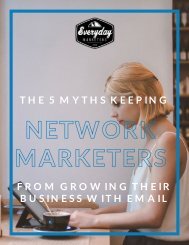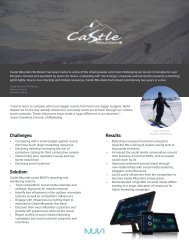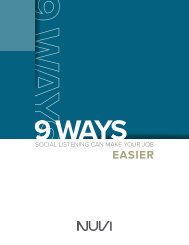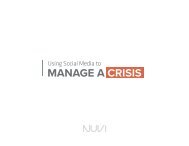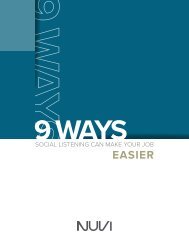PR GUIDE
You also want an ePaper? Increase the reach of your titles
YUMPU automatically turns print PDFs into web optimized ePapers that Google loves.
THE ULTIMATE <strong>GUIDE</strong><br />
TO COMBINING SOCIAL MEDIA AND<br />
DATA FOR BETTER <strong>PR</strong> RESULTS
<strong>PR</strong> is more important now than ever due to the trust created by<br />
high quality shared content. Did you know that 66% of consumers<br />
trust editorial coverage, but the trust in that same content jumps<br />
to 83% when shared by a third party? This unique ability to<br />
generate trust makes <strong>PR</strong> more valuable than traditional marketing.<br />
Furthermore, today’s audience is much more inclined to do<br />
extensive research before making a major purchase. In the<br />
past, it took about seven touches or interactions with a brand<br />
before making a decision. Today, that number has gone up to<br />
about 20. Your releases not only create trust, but also help your<br />
customers make a buying decision.<br />
NUVI collaborated with Serena Ehrlich of BusinessWire for a<br />
webinar and it was so successful we thought we’d supplement<br />
that information with a downloadable guide. Serena is the Director<br />
of Social and Evolving Media at BusinessWire. She has over 17<br />
years in the newswire industry and has worked with brands such<br />
as Kraft, Kohls, Avon, Mattel, and Mogreet, just to name a few.<br />
IN THIS <strong>GUIDE</strong> YOU WILL LEARN:<br />
Page 1<br />
• How to optimize your press releases for maximum shareability<br />
• How to use social to increase visibility<br />
• How to track shares and data to prove ROI
PART ONE:<br />
HOW TO OPTIMIZE FOR MAXIMUM<br />
SHAREABILITY<br />
HEADLINES<br />
As you begin to make your optimize your content, one of the<br />
easiest things to fix is often one of the most overlooked. The<br />
headline will make or break your release. This probably isn’t<br />
news to anyone reading this, and yet over and over we see<br />
headlines that limit shares.<br />
Page 2<br />
As you can see in the example above, these were two different press<br />
releases on the same subject and yet one was shared and significantly<br />
boosted web traffic. Why? Well, a big part of its success was the<br />
headline. In the example on the left, there is no “why” statement.<br />
There is nothing about it that gives the reader any incentive to read.<br />
Part of the problem is that it is a news release about a university<br />
offering a class. Not exactly big news.
Don’t settle for mediocre headlines! With just 10 minutes of research,<br />
you can produce effective headlines that drive shares. Follow these<br />
8 steps from BusinessWire:<br />
1. Write your news release like you always do<br />
2. Identify important keywords and phrases<br />
3. Go to Google Trends<br />
4. Change the location and timeline (timeline should be for last 7 days)<br />
5. Type in your keywords<br />
6. identify highest searched terms<br />
7. Add those keywords to your headline<br />
8. Finalize your relase<br />
You can see that the optimized headline on the right includes<br />
the trending term “Internet of things” as well as the why statement,<br />
“impact on Supply Chain.” This extra little bit of research yielded<br />
a headline that led to 3x leads and 12x ROI. Worth the 10 minutes?<br />
You bet.<br />
IMAGES<br />
Great, you’ve got a good working headline and a solid press<br />
release. However, don’t share it just yet, there is still a vital<br />
step you need to take before it is ready for publication. If you<br />
go back to look at the difference between the optimized and<br />
unoptimized press releases, you’ll notice one more glaring<br />
discrepancy: that’s right, one has an image, the other doesn’t.<br />
Images are now essential components of your press release. In fact,<br />
you should think of the text as a supplement to the visual asset.<br />
Page 3<br />
Images are important for two reasons: first, you are catering to<br />
a visually fluent audience. Whether we want to accept it or not,
we no longer live in a text based world; today’s audience is very<br />
dependent on image. This becomes a problem as many <strong>PR</strong><br />
people still typically think in text, not images. <strong>PR</strong> needs to evolve<br />
a more media-centric approach.<br />
Second, reporters won’t pick up your press release without<br />
multimedia assets. They are just way too busy to scour the<br />
internet for the right image to attach to your press release. In<br />
some cases, they may even take your release and then attach<br />
a competitor’s asset to it just to prove a point. Many, however,<br />
won’t even open it unless there is an image attached. If you want<br />
to get the most shares out of each release, you must optimize<br />
with an appropriate image/ multimedia asset.<br />
Page 4<br />
EMOTION MATTERS<br />
The third and final tip for optimization is that the emotion of<br />
the piece matters and will at least partially determine how often<br />
it is shared. Smart content shares. People love to share information<br />
that makes them look smarter to their peers. Second, people<br />
love negative/ fix - problem/solution stories. For example, a<br />
company is facing a serious problem and has done something<br />
revolutionary to fix it, people love to read and share those posts.<br />
Maybe it speaks to some intrinsic optimism we all share. Or<br />
maybe it is just entertaining. Regardless, this type of content<br />
is extremely shareable. On the other hand we have sad content.<br />
Sad doesn’t share. People don’t like reading it and are less<br />
inclined to share it. Now if it starts out as sad, like ducklings<br />
stuck in a storm drain, but then there is a happy resolution<br />
people will share it. Just a sad story? Not going to happen.
PART TWO:<br />
HOW TO USE SOCIAL TO<br />
INCREASE VISIBILITY<br />
Now that you have a fantastic release with a great headline<br />
and eye-catching multimedia, it is time to get as many eyeballs<br />
on your work as possible. You may be tempted to just hit publish<br />
and put it on the wire, but keep your audience in mind. Your<br />
average consumer sees around 5,000 messages per day.<br />
Overwhelming is an understatement. We only have so much<br />
attention, but the number of messages is constantly on the rise.<br />
So how do you make your release relevant and get<br />
it in front of as many people as possible? SOCIAL!<br />
Why use social media (asked no one ever)? People trust content<br />
shared by friends and family more than they trust content<br />
shared by brands. Your audience is more likely to read and<br />
engage with your content when it is recommended by someone<br />
they trust. Social media is the best way to get your<br />
release shared and made available. Another great benefit<br />
to social is that reporters read social shares. Thelikelihood of<br />
your release getting picked up and used by reporters increases<br />
significantly when shared on social. As we mentioned earlier,<br />
your audience is going to do their homework before making<br />
a decision to spend money. They want to learn as much<br />
about your brand as they can before making a purchase. Social<br />
is where many people conduct that research.<br />
Page 5
HOW TO GET THE MOST OUT OF SOCIAL<br />
1. Share your editorial coverage across your social channel at least<br />
15 times. Social networks are based on algorithms. For example,<br />
a typical post on Facebook will organically reach only 2-8% of<br />
those that follow your page. Likewise, Instagram has similar<br />
algorithms in place to show only what they consider the most<br />
relevant content at any given time. Therefore, the more times you<br />
post it, the more people will see it.<br />
2. Each social platform has a specific audience and specific use. For<br />
example, Twitter is used to share new information and customer<br />
service (complaints). So new information or releases with data<br />
do very well. On the other hand, Linkedin is more business-centric.<br />
Users are more about business and professional competition, so<br />
posts that follow a “read this and you’ll be better at your job”<br />
formula tend to get more shares. Keep in mind the aspirations<br />
of each channel and customize your release accordingly.<br />
3. Hashtags and keywords matter. We all have that one friend that<br />
includes no less than 25 hashtags for each and every post. And<br />
we all know how annoying it is to try and read their posts. According<br />
to ADWEEK, “Tweets with hashtags get twice the engagement of<br />
those without and are 55 percent more likely to be retweeted.<br />
But less is more: Tweets with only one or two hashtags have 21<br />
percent higher engagement than those with three or more. Like<br />
your optimized headlines, you want to make sure that you are<br />
customizing the titles and descriptions of your release for the<br />
different platforms you are using.<br />
Page 6<br />
As we mentioned before, images are crucial to getting your content<br />
in front of as many people as possible. As you get ready to post your<br />
relase across the different social networks, you should change the<br />
thumbnail because what works for Facebook may not be the same<br />
that works for Twitter or Linkedin. Again, you have to take into<br />
consideration the different audiences and the type of content they<br />
are used to sharing.
PART THREE:<br />
HOW TO TRACK SHARES AND<br />
DATA TO <strong>PR</strong>OVE ROI<br />
WhooHoo! You’re ready to take the most crucial step towards<br />
getting the credit you deserve as a <strong>PR</strong> professional. You’ve<br />
researched and created a great headline. You included a rich,<br />
shareable multimedia asset. You are proactively pushing your<br />
awesome release across multiple channels and platforms, each<br />
one with a customized title, description, and image. Give yourself<br />
a pat on the back because you are on your way. All you need<br />
now is the data to show the value you’ve created for your brand/ client.<br />
Now is the time to take credit for the increase in leads, subscribers,<br />
and website traffic.<br />
While it is important to know who read and shared your content,<br />
chances are your executive team wants to know more than<br />
just shares, engagements, and new followers. Beyond coverage,<br />
you need to connect your work to business goals in order to be<br />
competitive with marketing. Measurement is that vital step that<br />
has, up till now, differentiated marketing from <strong>PR</strong>. Marketing<br />
is used to measuring and showing data to validate their efforts,<br />
thus earning them all the recognition.<br />
Page 7<br />
USE A URL BUILDER/UTM LINK<br />
A big part of quantifying your success is monitoring the growth<br />
of inbound traffic as it correlates to your content. BusinessWire<br />
recommends using a tracking link in order to understand how<br />
many new visitors come to your site as a result of your release.<br />
They suggest using a URL builder or UTM link. They even wrote<br />
a handy blog about it in which they explain how important it is<br />
track your release.
“Provided by your analytics program, URL builders or UTM links<br />
are lines of text you add to the end of a URL that allow the<br />
program to track the inbound traffic activity you are generating.<br />
URL builders allow you to connect the dots between your reader<br />
and your website, tracking the impact of your communications<br />
program directly on your business goals.<br />
You can create new URL builders for every release and identify<br />
traffic by platform (one builder for all news releases vs. blog<br />
posts) or topic (one builder for all earnings vs. products).”<br />
With a URL builder in place, you can track:<br />
• Inbound traffic<br />
• Return visitor rates<br />
• First time visitor rates<br />
• Conversions<br />
• Downloads<br />
• Subscriptions<br />
• Click attribution<br />
Think of how useful that data will be when you present on the<br />
efficacy of your releases.<br />
Page 8<br />
MEASURING SOCIAL<br />
Part of an aggressive social campaign is strategic posting and<br />
content optimization. Another, equally important part, is measuring<br />
the impact and spread of social discussions around your content.<br />
It is this data that will show how your work aligns with business<br />
goals and allows you prove the impact you’ve had.
It can be extremely difficult and time consuming to compile<br />
reports on social media shares. There are multiple platforms and<br />
many different users who may share or talk about your post.<br />
A solid social listening and reporting tool is a huge time-saver<br />
for aggregating and organizing this data. For example, BusinessWire<br />
uses NUVI reporting to produce a report for each of their clients<br />
to show how each release spread and overall engagement. With<br />
this reporting in hand, it is a simple matter to present the reach<br />
and engagement for every single release that goes out. This<br />
data will go a long way towards validating ROI with leadership.<br />
CONCLUSION<br />
As a <strong>PR</strong> pro, you work very hard to craft compelling messages<br />
and then get that message in front of as many people as possible.<br />
You make significant contributions to website traffic, SEO, brand<br />
awareness, lead gen, and many other facets of growing a<br />
business. Social plays a vital role in the creation, distribution,<br />
and measurement of your impact on business goals. Getting your<br />
relase in front of as many people as possible with accompanying<br />
analytics will go along way to getting the <strong>PR</strong> results you are<br />
working for.<br />
Page 9




